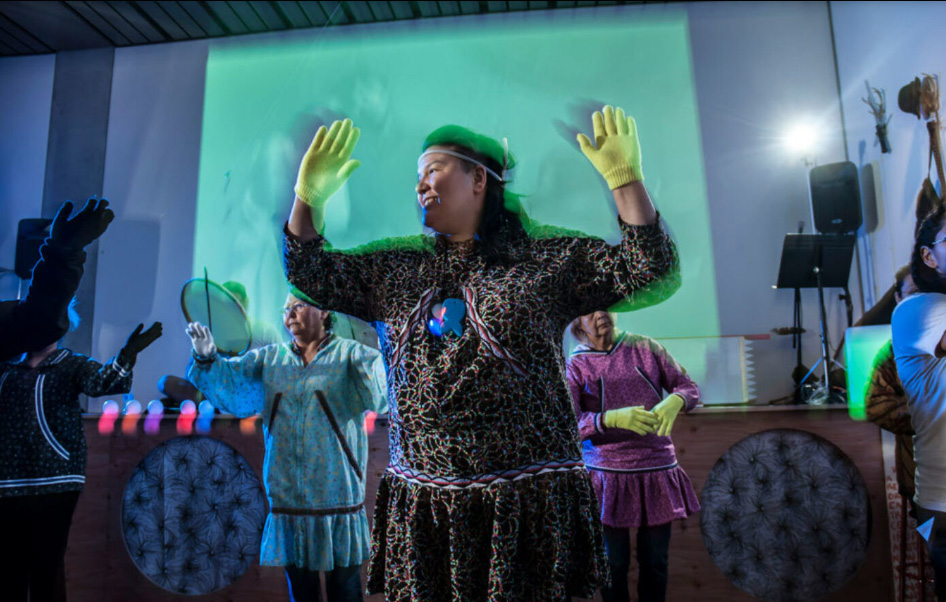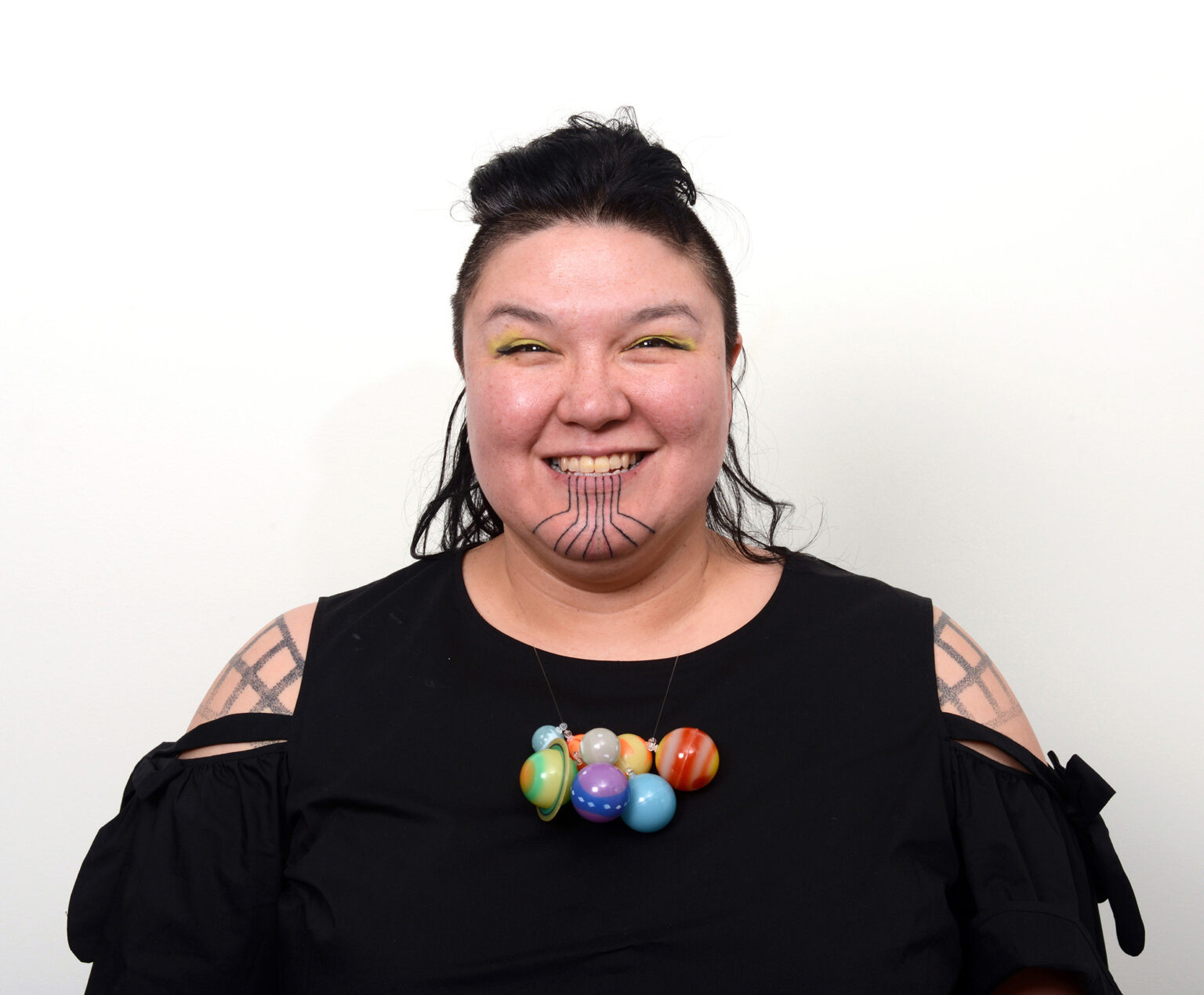
Her work is focused on performance, rap, installation and poetry. Warden found her calling to become an artist at a young age: “As a young Iñupiaq, I saw the impacts of the rapid colonization of my traditional homelands and how they manifested as disease in myself and also my family. I heard stories of my great-great grandfather and also my great-great grandmother, how they would utilize traditional methods to heal their communities collectively, and at a young age, I began to look towards the arts as a vehicle for possible neo-traditional community healing methods. My grandmother was known for getting audiences to laugh, and at a young age she recognized my talent in the performing arts and encouraged me to carry our Iñupiaq culture forward in unconventional ways.”

Among her recent work is the multimedia installation and two-month performance piece Unipkaaġusiksuġuvik (the place of the future/ancient), held at the Anchorage Museum in 2016. Warden created a futuristic version of a qargi (ceremonial and community house in the Iñupiaq language) and led events with audience participation. She described it a space “where the hyper-future meets the super-ancient, a liminal space where myths are born and the Eagle Mother is honored with ceremony and dance.” In 2017 she debuted siku/siku at the first Arctic Arts Summit in Harstad, Norway. Siku is one of the words for ice in Iñupiaq, and it has been used as slang for methamphetamine, part of the devastating drug misuse problems in the Arctic. According to the artist’s website, “the performance serves to illustrate the impact of the rapid colonization of her traditional homelands and how one life can be very different, just through a few different choices, circumstances and reactions an individual has towards life’s challenges, especially systemic barriers, including racism.”
Warden shared that from a young age the people in her life – teachers, family and others around her – supported and inspired her in exploring the arts. One person was the non-Native Alaska artist Claire Fejes. “She was [already] pretty famous as an artist and my babysitter,” Warden said. “She soon recognized I was an artist, encouraged me, and even gave me a painting as a child. I remember her acknowledging that she saw something in me that reminded her of what she did in her early years.”
One approach Warden utilizes in her work is finding intersectionality within a project as a way to explore issues and to educate people. She uses an analytical approach to understanding commonalities and differences between Alaska Native and non-Native experiences to understand aspects of people’s social and political identities. “There are ways to communicate culture in a way that doesn’t need to be linear or logical,” Warden said. “I’m a performer, so I’ve had to put my body on the line and consider what I want to say and be present, face to face with the people. I love poetry because I can write it in quiet privacy in a place, setting, and time of my choosing.”
Regarding her performance art, Warden shared, “I have to say from my personal experience, I was seeking to stretch the content of what is available for Alaska Native artists. I appreciate artists like James Luna.” Luna (1950-2018) was a Puyukitchum/Ipai/Mexican-American Indian performance artist, photographer and multimedia installation artist. His work is well known for challenging the status quo within conventional museum exhibitions and how they present Native Americans.

Warden is committed to becoming fluent in and helping revitalize her Iñupiaq language, and to bringing her language into her art. In a 2019 interview with Katherine Brewer Ball, Warden said that “in my dreams I have ancestors who are encouraging me and talking to me, so I feel like it’s my responsibility, and I love putting it in my art. Being an Indigenous artist, we have cultural responsibilities. . . Bringing the language forward is both a gift and a responsibility. There is so much wisdom in the language. So much of our worldview is the language, our Iñupiat way of seeing the world, and it doesn’t translate into English.”
Warden’s work has been recognized and supported through fellowships in Alaska and nationally. In 2018, she received a Rasmuson Individual Artist Fellowship in the field of New Genre, which supported her travel to Abu Dhabi to begin research for Everybody Will Be a Millionaire, a collaboration with Iñupiaq photographer Brian Adams that will debut in 2025. In the same year, she was awarded a Native Arts and Cultures Foundation National Artist Fellowship in the field of music. In 2019, she was awarded the prestigious United States Artist Fellowship. Currently Warden is working on her poetry and a hip-hop album that is expected to be released before December.
Author Biography
Richard Perry from Anchorage, Alaska, is Yup’ik and Gwich’in. He is a writer, journalist and photographer with a BA in Philosophy, Applied Ethics. He has regularly published articles and photos in Indian Country Today, First Alaskans magazine, and Alaska Business Monthly. In 2016, Perry completed a month-long artist residency at the Tyrone Guthrie Centre in Ireland. More recently, he has written a graphic novel called the Wildmen of Denali, which is currently in the process of being illustrated.
Dawn Biddison is the Museum Specialist at the Alaska office of the Smithsonian Arctic Studies Center. Since 2002, she has worked with Alaska Native Elders, artists, educators, scholars, knowledge-keepers and cultural organization staff. Her work began with museum research, exhibition, catalog and website work. Since 2010, her work shifted to outreach with Alaska Natives through collaborative community-based cultural heritage projects that include facilitating museum collections access, artist residencies, community workshops, public programs and equitable documentation that respects Indigenous protocols and goals, supports intergenerational learning, and provides ongoing, accessible educational resources through print and online distribution. You can see examples of her work on the Smithsonian Learning Lab site, “Smithsonian Arctic Studies Center in Alaska.”
Acknowledgements
This article was funded in part by a grant from the United States Department of State. The opinions, findings and conclusions stated herein are those of the author[s] and do not necessarily reflect those of the United States Department of State.
This story is part of the Alaska Spotlight. View more content from the Spotlight here.

